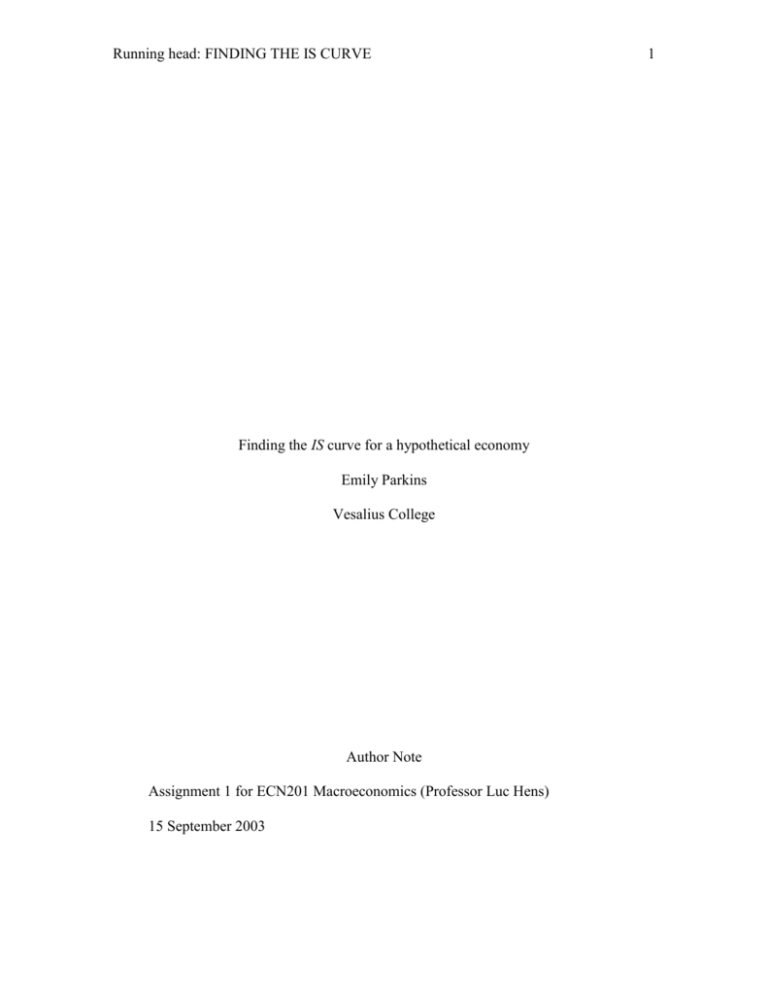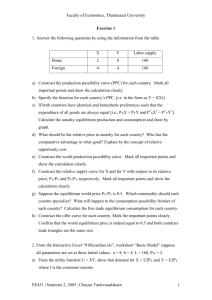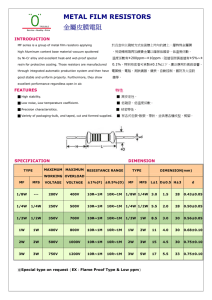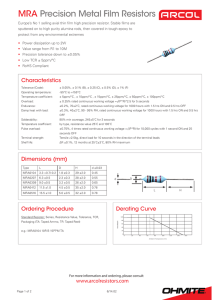
Running head: FINDING THE IS CURVE
Finding the IS curve for a hypothetical economy
Emily Parkins
Vesalius College
Author Note
Assignment 1 for ECN201 Macroeconomics (Professor Luc Hens)
15 September 2003
1
FINDING THE IS CURVE
2
Abstract
For a hypothetical economy described by a given set of structural equations, I use algebra
to derive the demand for domestic final product. The equation shows that when income
increases by US$1 billion, demand for domestic final product increases by US$0.6
billion. When the interest rate increases by 1 percentage point, demand for domestic final
product falls by US$10 billion. The IS curve equation shows that, if the goods market is
in equilibrium and the interest rate increases by one percentage point, output has to
decrease by US$4 billion to maintain equilibrium.
EconLit subject codes: E120, E200
FINDING THE IS CURVE
3
Finding the IS curve for a hypothetical economy
The purpose of this paper is to illustrate in a model of a hypothetical economy
how the equilibrium in the goods market is determined when both income and the interest
rate are endogenous. I derive the equation describing equilibrium in the goods market
(the IS schedule) using algebra.
The structure of the goods market of a hypothetical economy given in Gordon
(1998, p. 121, problem 1) is represented by the following equations:
C = a + 0.75(Y-T)
(1)
a = 50 - 10r
(2)
T = 200 + 0.2Y
(3)
Ip = 300 - 30r
(4)
G = 400
(5)
No units of measurement are given; I assume that C, Y, T, a, Ip, and G are all measured in
billions of US$. The interest rate r is measured in percent.
The demand for domestic final product (Z) is:
Z = C + Ip + G + EX - IM
(6)
As no information is provided on exports (EX) or imports (IM), I assume the economy is
closed and both exports and imports equal zero. Demand for domestic final product
(planned expenditures) then reduces to:
Z = C + Ip + G
(7)
Substitute the given functions for C (equations 1 and 2), Ip (equation 4) and G (equation
5) into equation 7, to obtain planned expenditures:
Z = (50 - 10r) + 0.75 [Y - (200 + 0.2Y)] + 400
(8)
FINDING THE IS CURVE
4
Expanding and grouping terms in r and Y yields:
Z = [50 - (0.75)(200) + 400] - 10r + [0.75 - (0.75)(0.2)]Y , or:
Z = 300 - 10r + 0.60Y
Hence the planned expenditures equation is:
Z = 300 - 10r + 0.60Y
(9)
When income increases by US$1 billion, demand for domestic final product increases by
US$0.60 billion. When the market interest rate increases by 1 percentage point, demand
for domestic final product falls by US$10 billion.
The IS-curve represents all combinations of income (Y) and interest rate (r) at
which the goods is in equilibrium (Blanchard, 2006, p. 95). The goods market is in
equilibrium when the supply of domestic final product (Y) equals demand for domestic
final product (Z):
Y=Z
(10)
Substitute the expression Z = 300 - 10r + 0.60Y derived above for Z to rewrite the
equilibrium condition as:
Y = 300 - 10r + 0.60Y
(11)
Solve for income (Y):
Y - 0.60Y = 300 - 10r
, or
0.40Y = 300 - 10r
, or
Y = (1/0.40) (300 - 10r)
, or
Y = 120 - 4r
Hence the equation for the IS curve (see figure 1) is:
Y = 120 - 4r
(12)
FINDING THE IS CURVE
If in goods market equilibrium the interest rate increases by one percentage point, output
has to decrease by US$4 billion to maintain equilibrium.
Figure 1. IS curve (Y = 120 – 4r) representing equilibrium in the goods market
5
FINDING THE IS CURVE
6
References
Blanchard, O. (2006). Macroeconomics (4th ed.). Upper Saddle River, NJ: Pearson
Prentice Hall.
Gordon, R. J. (1998). Macroeconomics (6th ed.). Maddison, MA: Addison-Wesley.












